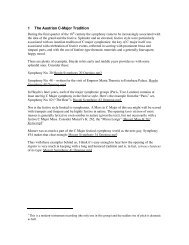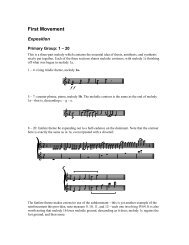Mozart Symphony No. 39 (PDF) - Scott Foglesong
Mozart Symphony No. 39 (PDF) - Scott Foglesong
Mozart Symphony No. 39 (PDF) - Scott Foglesong
Create successful ePaper yourself
Turn your PDF publications into a flip-book with our unique Google optimized e-Paper software.
2.4.6 Fourth Movement<br />
The practice of having the winds finish up a theme started by the strings (there’s a note about that<br />
in the first movement) is aptly demonstrated by 42 – 52. Here, the melody is really tossed around<br />
between the two, with the entrances overlapping a bit when the strings reclaim the theme. IV - 42<br />
- 52.mp3<br />
2.5 Viola<br />
<strong>Mozart</strong> lived in an era when the viola was very much the brunt of a lot of jokes, most of which<br />
were just as true in their own day as they are in ours. Probably even more so, since the viola<br />
section in many orchestras was actually filled by violinists who just weren’t considered good<br />
enough to play in the violin section.<br />
The usual treatment of the viola is the upper octave of the bass line, which was frequently written<br />
in two octaves: the violas on the top, the celli in the middle, and the basses below. If the viola is<br />
not being used as part of the bass line, it is usually doubling—or nearly so—the accompaniment.<br />
<strong>Mozart</strong> did break away from this somewhat, but not very much. I’ve done a bit of statistical<br />
counting of the first movement to find out how he treats it.<br />
There are two indicators you can use to indicate the relative strength of a string instrument: times<br />
when it is used to carry the melodic line, or is heard solo, and the amount of divisi or double-stop<br />
writing it contains.<br />
2.5.1 Melodic Lines<br />
I have constructed this table of those parts of the first movement in which the viola is used in a<br />
way that is not either doubling the bass line or reinforcing the middle harmonies.<br />
<strong>39</strong> Alone, playing a bridge passage<br />
115 – 116 Short countermelody, acting as an accompaniment<br />
152 – 153 Same as 115 – 116 (in development)<br />
196 Same as <strong>39</strong> in recap<br />
208 – 209 Quasi-countermelody, although still accompaniment<br />
271 – 272 Same as 115 – 116 (in recap)<br />
The result is: 10 measures out of 309, and never at any point carrying really important material.<br />
Even the tiny solo in <strong>39</strong> & 196 is only a ‘tail’ type bridge, relatively unimportant. (It could even<br />
be omitted if one’s violas were bad enough!) The ten measures account for 3.2% of the<br />
movement—thus the violas are obviously 3 rd -class citizens at best.<br />
2.5.2 Divisi and Double (Triple) Stop Writing<br />
The viola line, like the clarinet, bassoon, trumpets, horns, and string lines, is sometimes written<br />
with more than one note at a time. This would indicate that the section either plays divisi (even<br />
though it may not be marked as such per se) or that the players use double stops. It’s usually not<br />
to difficult to ascertain which would be which, although obviously an orchestra would have a<br />
certain amount of latitude as to how they’re going to treat this. (An orchestra with weaker players<br />
might well divide up all double-stop passages, no matter what.)





